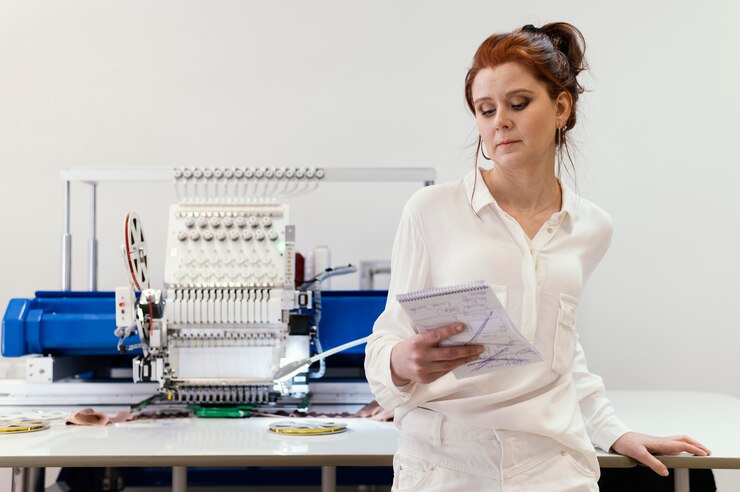01 Oct

|
Getting your Trinity Audio player ready...
|
This blog discusses how rapid technological advancements are revolutionizing the textile industry by transforming traditional processes.
It offers insights for textile manufacturers aiming to stay competitive and for technology enthusiasts interested in industrial innovations, highlighting the industry’s evolution to meet modern demands.
Table of Contents
The Evolution of Textile Manufacturing
Textile manufacturing has a rich history, dating back to ancient times when garments were handwoven on looms. For centuries, this labor-intensive process remained largely unchanged, until the Industrial Revolution sparked a wave of mechanization. The introduction of spinning jennies and power looms revolutionized production, significantly boosting output and efficiency.
The dawn of automation in the 20th century marked another pivotal moment. Automation brought about a new era where machines could handle repetitive tasks with precision and speed, reducing human error and labour costs. This shift not only increased productivity but also opened doors for innovation, allowing manufacturers to explore new fabrics and designs previously unimaginable.
Today, textile manufacturing is witnessing yet another transformation, driven by the integration of cutting-edge technologies. From 3D printing to smart fabrics, including innovative hook and loop fabric, these advancements are redefining what is possible in the industry, offering solutions that are both innovative and sustainable.
Cutting-edge technologies in Textile Manufacturing
3D Printing in Textiles
3D printing, once limited to prototyping, has evolved into a powerful tool for textile manufacturing. By using additive manufacturing techniques, companies can create complex designs that were previously unachievable with traditional methods. This technology allows for customization, enabling designers to create bespoke garments that fit individual needs.
In addition to customization, 3D printing reduces waste by producing only what is needed. This aspect is particularly appealing in today’s eco-conscious market, as it aligns with sustainable practices. Companies have embraced 3D printing to create innovative products, such as their Futurecraft sneakers, which feature a 3D-printed midsole for enhanced performance and comfort.
3D printing’s ability to swiftly adapt to design changes makes it a valuable asset for manufacturers looking to stay ahead of trends. By reducing lead times and minimizing material waste, 3D printing offers a competitive edge in a fast-paced market.
Smart Fabrics and Wearables
Smart fabrics and wearables represent a frontier where textiles and technology converge. These fabrics incorporate electronic components to monitor and respond to environmental stimuli, offering functionalities beyond traditional textiles. From fitness tracking to temperature regulation, smart fabrics enhance the user experience by providing added value.
The versatility of smart fabrics positions them as a key player in the future of textiles. Their ability to seamlessly merge fashion with function makes them a sought-after commodity in an increasingly connected world.
Sustainable Textile Manufacturing Technologies
Sustainability is a pressing concern for the textile industry, known for its environmental impact. Innovative technologies are emerging to address this challenge, paving the way for greener manufacturing practices. From waterless dyeing techniques to biodegradable materials, these advancements aim to minimize the industry’s carbon footprint.
Waterless dyeing, for instance, eliminates the need for large volumes of water, a major resource in traditional dyeing processes. This method not only conserves water but also reduces the release of harmful chemicals into the environment. Companies like DyeCoo have adopted this technology, demonstrating its feasibility on an industrial scale.
Biodegradable textiles offer another sustainable solution, breaking down naturally without leaving harmful residues. These materials are gaining traction among environmentally conscious consumers, pushing manufacturers to innovate and adopt eco-friendly practices.
The Future of Textile Manufacturing
The future of textile manufacturing is poised for further transformation, driven by advancements in technology and changing consumer preferences. As the demand for sustainable and personalized products grows, manufacturers must adapt to remain competitive.
Emerging trends indicate a shift towards circular economies, where resources are reused and recycled to minimize waste. Technologies like blockchain could play a role in this transition, offering transparency and traceability throughout the supply chain.
Automation and AI are set to revolutionize how textiles are produced, with the potential to optimize efficiency and reduce costs. By leveraging data-driven insights, manufacturers can tailor their offerings to meet consumer demands, enhancing customer satisfaction and loyalty.
Collaborations between tech companies and textile manufacturers will likely increase, fostering innovation and expanding the possibilities of smart textiles. This synergy will pave the way for groundbreaking products that combine fashion with functionality, catering to an increasingly interconnected world.
Conclusion
Now that we have explored the impact of technology on the textile industry, it is clear that the future holds exciting possibilities. With 3D printing, smart fabrics, and sustainable manufacturing technologies, the boundaries of traditional textiles are being pushed further than ever before.


